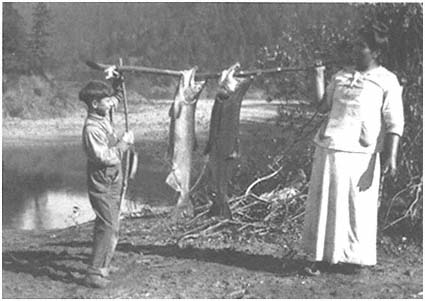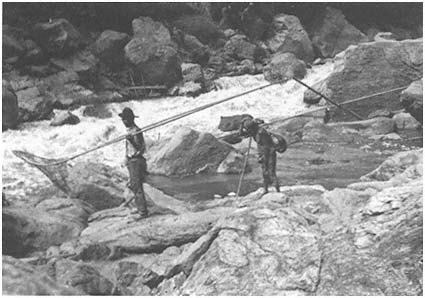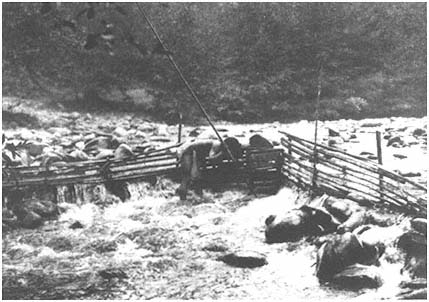Chapter Two—
The Klamath River Fishery:
Early History
Ronnie Pierce
"The present is the living sum total of the past." This observation applies directly to an understanding of the Indian fisheries of northern California's Klamath River. Two distinct pasts of the indigenous river people, the precontact and the postcontact eras, have merged to create the complex tangle of tribal values, economic realities, political, legal, and environmental concerns that exists today. To understand the current status of the Indian fishery, the controversy, and the confusion surrounding Indian fishing rights, one must understand both of these pasts.
Precontact Era
The aboriginal territory of the Yurok people encompassed riparian lands along the lower forty miles of the Klamath River, from its confluence with the Trinity River, its major tributary, to the Pacific Ocean. It also included coastal lands from a few miles north of the river's month south to Trinidad. The Yurok people have lived and fished on the Klamath River from time immemorial. The river was their world. North, south, east, and west did not exist for them. The only directions were upriver or downriver. The center of their world was Qu'-nek, where the Klamath joins the Trinity.
As the Yurok world centered on the river, the peoples' lives centered on its fish. Salmon especially, but also steelhead, lamprey,

Anthropologists termed it "primitive affluence." The chinook salmon
held by this Indian woman and boy were an important element in
the coastal Indians' "food bank."
(Peter Palmquist collection)
and sturgeon, were the mainstay of Yurok subsistence. The awesome, cyclical nature of the salmon's yearly migrations over the centuries influenced almost every aspect of Yurok life. Religion, lore, law, and tribal technology all evolved from the Indians' relationship with their fishery resources.
Such dependence on salmon required conservation measures to assure that the bounty would continue. The downriver Yuroks had to let enough salmon escape to perpetuate future generations and to meet subsistence needs of upriver tribes, the Hupas and Karoks. These two needs, biological and social, for an adequate salmon escapement were met with many rituals and laws that tempered the salmon harvest.
To the aboriginal Yurok, fishing sites were (and to a great extent still are) considered privately owned. The right to fish at a particular site was transferable and governed by complex rules and laws. Rights could be loaned for a portion of the harvest. Owners of the

Indian property. Elderly Indian couple at a "usual and accustomed"
fishing site on the Klamath River. Such sites were held and
controlled by Indian families.
(Peter Palmquist collection)
best sites were generally the "aristocrat" families of the tribes. Fishing techniques varied with the topography of the site and the type of fish being sought. Several types of nets, woven with twine made from iris leaf fibers, were used for salmon. Private ownership of restricted net fishing sites, however, could not ensure adequate subsistence for all Yuroks, so communal fish dams were temporarily built at selected sites. These weirs, constructed of log frames and a latticework of slats or poles that completely crossed the stream, blocked upstream fish migration. Sections could be opened to allow fish passage. Trapped fish were removed by dipnets and other means.
Possibly the most advanced accomplishment of California Indian cultures was the fish dam on the Klamath at Kepel. Several hundred people were involved in the annual construction of this dam. Every aspect of its construction and use was highly ritualized: it consisted of exactly ten panels, was built in ten days, and was fished for only ten days. This community project ensured that subsistence needs of all river tribes would be met, and salmon runs perpetuated.

Weirs such as this on the Klamath River were commonly used to intercept
migrating adult salmon. Yurok Indians observed complex rituals
associated with the annual construction and operation of much
larger community weirs on the lower Klamath.
(Peter Palmquist collection)
Neither net nor weir fishing could begin until the "first salmon" ceremony took place at Welkwaw, at the mouth of the Klamath River. The tribal formulist, after complex ceremonial rites, would ritually "spear" the first salmon. No person could eat salmon until this ceremony was completed.
Aboriginal Klamath fishers faced basic fishery management problems like those of today: how to cope with natural fluctuations in resources, how to control harvest while maintaining a viable economy. The Indians needed fish to survive. Clearly, as historian Arthur McEvoy has noted, Indian communities, over the centuries, learned how to "balance their harvest of fish with their environments' capacity to yield them." Salmon runs continued. Settlers of the 1850s reported that the Klamath was "alive with the finny tribe." Such was the Yurok world when the first major immigration of non-Indians arrived at the Klamath River.
Postcontact Era
Except for meeting a few explorers and fur traders, Klamath/Trinity tribes had little contact with whites before 1850. The California Gold Rush changed that dramatically. Gold seekers started settlement of the region, and reports of hostile contacts between whites and Indians were increasingly heard. Settlers demanded that Congress resolve the "Indian problem." Department of Interior Agent Redick McKee negotiated peace treaties that would preserve a small portion of tribal home territories while ceding all other lands to the state. Indians were to be taught to become farmers to lessen their dependence upon game and fish for food. Their leaders were given a choice: Be peaceful and sign the treaties, or be killed or driven out of the Country. At 4:00 P.M. , October 9, 1851, Indian leaders signed the treaties.
The new Californians did not want reservations. The most vocal called for termination or removal of Indians, although there were no lands farther west where Indians could be transferred. An editorial in the Los Angeles Star of March 13, 1852, summed up the popular attitude: "To place upon our most fertile soil the most degraded race of Aborigines" on the continent and treat them "as powerful and independent nations, is planting the seeds of future disaster and ruin." A beleaguered Congress ultimately met in secret session in 1852 and rejected all eighteen California treaties. (The injunction of secrecy was not removed until a half-century later.) This action still clouds certain legal aspects of California Indian fishing rights.
Meanwhile, as white immigration increased, Indian lands remained unprotected and confrontations, often genocidal, increased. President Franklin Pierce finally, in 1855, established the lower Klamath River Reservation and set up a military post, Fort Terwer, "to lessen friction between the new Californians and the Indians." Early superintendents of the Klamath Reservation struggled to adapt the Indian people to an agricultural life-style on the rich lands of the estuary, but the Yurok fishers resented field work. They preferred to subsist on fish and native roots, berries, and seeds. They simply wanted to be left alone, unmolested by whites.
Indians' distress with forced agricultural labor was relieved dramatically during the winter of 1861–1862, when a flood destroyed
the agency office and wiped out Indian dwellings, crops, and fields. Subsequently, the agent and staff were transferred north to Smith River. Although they were destitute, the Yuroks refused to relocate and were left to fend for themselves on the Klamath. This development, among others, led agency authorities to consider reorganizing all California Indian affairs. One result was the Four Reservations Act of 1864, which eventually established the Hoopa Valley Indian Reservation on the Trinity, upriver from the Yuroks. This putative abandonment of the Klamath Reservation was yet another glitch in the bureaucracy that in the future would prove a hindrance to the affirmation of Yurok fishing rights.
White immigration to Indian territory increased, and along with it the impact on salmon and other Indian fishery resources. Mining in headwater regions destroyed fish habitat, and miners drove Indians away from upper areas of the river. The conflict between Indian cultural fishing values and non-Indian industry had begun in earnest.
Predictably, confusion over reservation boundaries and locations led to further influx of squatters and increased pressure on government to remove the Indians and open the territory to homesteading. An army report in 1875 disclosed that the Yurok's main concern was their fish and predicted serious trouble if whites continued trespassing. Over subsequent years, squatters were ordered to leave, but the orders were largely ignored. A small military outpost was established at Requa to protect the Indians' fishing endeavors and attempt to maintain peace.
On April 1, 1876, the state of California legalized the sale of salmon caught in Del Norte, Humboldt, Shasta, and Mendocino counties. A non-Indian, Martin Van Buren Jones, soon established a commercial fishery at the mouth of the Klamath but was evicted by the army. He then moved his operation a mile tip Hunter Creek, just beyond reservation boundaries. Since Indians benefited from this endeavor, the military did not object.
Thus the lower Klamath River Indians entered a new era. White men's dollars, instead of barter, paid for their harvest of fish and allowed them to earn a living as the white world required. Commercial salmon fishing was most suitable to Indians, as this was what they could do best. In 1886, John Baumhoff, owner of a saltery also on Hunter Creek, signed an agreement with twenty-six male
Yuroks who may be considered the founders of the first Indian fisherman's union. He agreed to provide nets and boats and to pay Indian workers ten cents for every salmon weighing over ten pounds. The participating Yurok fishermen agreed to fish for no other non-Indian operation.
Baumhoff may have anticipated incursion from another white entrepreneur. One Richard D. Hume, of the Atlantic Coast family who introduced salmon canning to California in 1864 and later moved to the Columbia, had applied unsuccessfully to the Department of Interior in 1883 to fish the Klamath estuary. In 1887, defying the governmental injunction, he brazenly entered the estuary with a small steamer outfitted to catch salmon, claiming that he was not on the land of the reservation but on navigable waters open to all. Brandishing a large-bore Henry Express rifle, he quickly won the first argument with the local military sergeant. Soon he brought in a large barge outfitted to salt fish and house his non-Indian crew.
Indian fishermen, who had labored to clear net-snagging debris from the river bottom, soon were in direct competition and conflict with Hume's fishermen. They requested governmental relief. Indian agents, ducking the navigable waters question, lodged criminal charges against Hume for unlicensed trading with Indians on the reservation. Large stocks of trade items and receipts of transactions with the Indians had been found on his barge, the first listed item being forty-eight pounds of Rising Star Tea.
In the case of United States v. 48 Lbs. of Rising Star Tea, the United States attorney did not appear, so neither the government nor the Yurok tribe was represented. Hume's attorneys won the case, the judge ruling that the Klamath River Reservation no longer had legal status due to its "abandonment" in 1862. In 1889 the U.S. Circuit Court affirmed the ruling. Although the Rising Star Tea case actually had little adverse effect on the Indian fishery at the time, it did add to future confusion over the reservation's status and Indian fishing rights.
During the period 1880 to 1891 no fewer than eleven different congressional bills were submitted to open the Klamath Reservation lands to homesteading. To resolve the matter, the federal government in 1891 extended the boundaries of the Hoopa Valley Reservation to include not only the first Klamath Indian Reserva-
tion on the lower river but also the land along the stretch of river connecting the two reservations, thus creating one reservation slightly larger than the two original reservations. That same year the California State Legislature decreed that the river was not "navigable water."
Congress seemed unaware of the formation of the enlarged Hoopa Reservation. In January 1892, just three months after the consolidation of the reservation, yet another homesteading bill, HR 38, was introduced. All lands of the original Klamath Reservation were to be subject to entry, settlement, and purchase by whites. Proceeds of the sale were to be directed toward removal, maintenance, and education of resident Indians. The House Committee on Indian Affairs concurred with the bill, arguing that allotments to the Indians prior to the public offer would be ill advised as the Indians "have no conception of land values or desire to cultivate the soil." (Little had changed on that subject over the preceding forty years.) The bill passed the House and Senate essentially as written, except that Indians residing on the old Klamath Reservation would be given allotments rather than be removed.
The ancient Indian village of Rek-woi (Requa by then), at the mouth of the Klamath, flourished under the dominance of white settlers. During the salmon runs, Indian people from upriver and neighboring territories came to work as commercial fishers and cannery employees. The few Yurok people who had survived wars, disease, and genocide moved into the twentieth century still situated oil their aboriginal homeland and still closely tied to their life-sustaining resource, the salmon. But they were to face major assaults on that resource.
The question of navigability and the subsequent legal jurisdictional status and ownership of the bed of the Klamath River had been left unresolved in the Rising Star Tea case. In 1901, a murder was committed in reservation waters of the Klamath River, and the subject of court jurisdiction reopened the question of navigability. Upon admission to statehood, a state usually acquires sovereign ownership and control of all navigable waterways and the underlying beds. Thus the question arose in Donnelly v. United States: Should James Donnelly, the accused murderer, be tried in federal court for an act committed on a federal reservation or in a state court for a crime committed in "state waters"?
The fact that California had become a state prior to creation of the reservation in 1855 argued for state jurisdiction. But, on the other hand, California, on April 13, 1850, preceding statehood, had adopted English common law, under which all nonnavigable river-beds would be transferred to their proprietors, in this case the United States. Since the state had repealed the status of navigability of the river in 1891, the court held that the bed of the river was an integral part of the reservation and therefore under United States jurisdiction. Moreover, the judges found it absurd to consider that the reservation would be created to include the steep mountainous slopes on either side of the river but not the river itself, as it had been created for the Indians to "gain a subsistence by fishing."
Donnelly was convicted on other points, but his lawyers, in requesting a rehearing, focused on the riverbed issue. The court, maintaining that the river's legal status was peripheral to the case, recalled its position on that point and refused further oral argument.
Thus, with the question of title to the riverbed left unanswered and the status of the reservation left clouded by white settlement under the act of 1892, the state of California continued its presumed authority and regulation of all fishing activities on the lower Klamath.